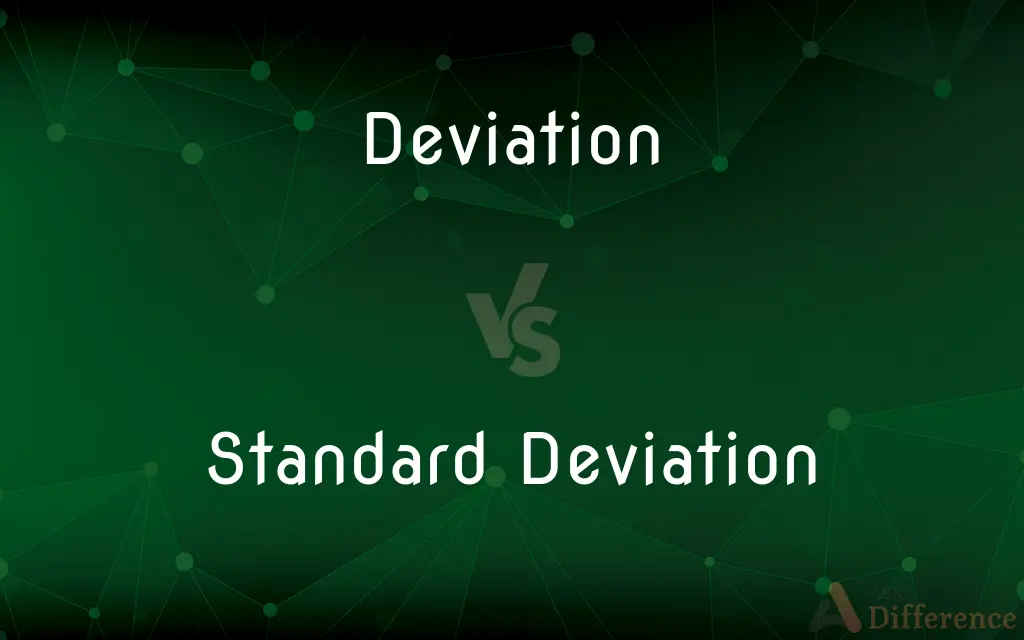Deviation vs. Standard Deviation — What's the Difference?
By Maham Liaqat & Urooj Arif — Published on February 21, 2024
Deviation measures the difference between each data point and the mean, while Standard Deviation quantifies the dispersion of data points around the mean in a dataset.

Difference Between Deviation and Standard Deviation
Table of Contents
ADVERTISEMENT
Key Differences
Deviation in statistics refers to the difference between an individual data point and the mean of the dataset. It highlights how far each observation is from the central value, without indicating the direction (positive or negative). Standard Deviation, on the other hand, is a measure that quantifies the amount of variation or dispersion of a set of data points. It is calculated by taking the square root of the average of the squared deviations from the mean, providing a consistent measure of spread around the mean.
Deviation is a simple concept that lays the foundation for understanding more complex statistical measures like Standard Deviation. While deviation gives an idea of the distance of each data point from the mean, it does not provide a comprehensive picture of the dataset's overall variability. Standard Deviation builds on the concept of deviation by squaring the differences, averaging them, and then taking the square root, which helps in understanding the dataset's variability in a more meaningful way.
The value of deviation can be positive or negative, depending on whether the data point is above or below the mean, respectively. However, when calculating Standard Deviation, squaring the deviations ensures that all values are positive, emphasizing the magnitude of deviation without regard to direction. This makes Standard Deviation a useful tool for comparing the spread of different datasets.
Standard Deviation is widely used in various fields, including finance, research, and engineering, to assess the reliability and variability of data. It helps in making informed decisions based on the expected range of variation in data. Deviation, while a simpler concept, is crucial for calculating Standard Deviation and understanding the distribution of individual data points relative to the mean.
Deviation provides a basic understanding of how individual data points differ from the mean, whereas Standard Deviation offers a comprehensive measure of the overall variability within a dataset, making it indispensable for statistical analysis and interpretation.
ADVERTISEMENT
Comparison Chart
Definition
Difference between a data point and the dataset's mean
Square root of the average of squared deviations from the mean
Values
Can be positive or negative
Always non-negative
Purpose
Measures individual data point's distance from the mean
Quantifies overall dispersion of data points around the mean
Use in Analysis
Basis for more complex statistical measures
Widely used to assess data variability and consistency
Compare with Definitions
Deviation
Helps in understanding data distribution.
Analyzing deviations in patient recovery times can help identify outliers.
Standard Deviation
A measure of data spread around the mean.
A low Standard Deviation in investment returns signifies stable performance.
Deviation
The difference between a data point and the mean.
The deviation of a test score from the class average shows individual performance relative to the group.
Standard Deviation
Calculated as the square root of the variance.
Standard Deviation provides a clearer measure of variability than variance due to matching units with the original data.
Deviation
Indicates how far a data point is from the average.
A large deviation in temperatures from the seasonal average can indicate unusual weather patterns.
Standard Deviation
Essential for statistical analysis.
Standard Deviation is crucial in determining the significance of experimental results.
Deviation
Can be positive or negative.
Negative deviation occurs when sales are below the monthly average, indicating a need for analysis.
Standard Deviation
Indicates consistency in data.
High Standard Deviation in manufacturing processes can signal quality control issues.
Deviation
The difference between an observed value and the expected value of a variable or function
Standard Deviation
Used to compare different datasets.
Comparing Standard Deviations helps determine which dataset is more variable.
Deviation
Essential for calculating Standard Deviation.
Summing the squared deviations is the first step in computing Standard Deviation.
Deviation
The difference between an expected value of an observation or measurement and the actual value.
Common Curiosities
How is Standard Deviation calculated?
Standard Deviation is calculated by taking the square root of the average of the squared deviations from the mean.
Can deviation be negative?
Yes, deviation can be negative if the data point is below the mean.
Why is Standard Deviation important?
Standard Deviation is important because it quantifies the variability or dispersion of a dataset around the mean, indicating consistency or variability.
What does a high Standard Deviation indicate?
A high Standard Deviation indicates a wide spread of data points around the mean, suggesting high variability.
What is deviation in statistics?
Deviation is the difference between an individual data point and the mean of a dataset.
Does Standard Deviation account for direction?
No, Standard Deviation does not account for the direction of deviation; it measures the magnitude of variability.
Can we compare datasets using Standard Deviation?
Yes, comparing the Standard Deviations of datasets can provide insights into their relative variability.
How does the size of the dataset affect Standard Deviation?
The size of the dataset can influence the accuracy of Standard Deviation; larger datasets may provide a more reliable measure of variability.
How does squaring deviations affect Standard Deviation?
Squaring deviations ensures all values are positive, emphasizing the magnitude of deviations without considering their direction.
Can Standard Deviation be zero?
Standard Deviation can be zero if all data points are identical, indicating no variability.
How do deviation and Standard Deviation differ in their application?
Deviation is used to understand the distance of individual data points from the mean, while Standard Deviation assesses the overall variability within a dataset.
Is Standard Deviation always positive?
Yes, Standard Deviation is always non-negative because it is derived from squared values.
What role does mean play in calculating deviation?
The mean serves as a reference point for calculating the deviation of each data point, indicating how far each value is from the average.
Why is deviation not always useful on its own?
While deviation shows the distance of each point from the mean, it does not provide a consolidated measure of variability, which is where Standard Deviation comes in.
What is the relationship between variance and Standard Deviation?
Variance is the average of the squared deviations, and Standard Deviation is the square root of variance, providing a measure of spread in the same units as the data.
Share Your Discovery

Previous Comparison
PUBG Lite vs. Free Fire
Next Comparison
Elastic Collision vs. Perfectly Elastic CollisionAuthor Spotlight
Written by
Maham LiaqatCo-written by
Urooj ArifUrooj is a skilled content writer at Ask Difference, known for her exceptional ability to simplify complex topics into engaging and informative content. With a passion for research and a flair for clear, concise writing, she consistently delivers articles that resonate with our diverse audience.
















































